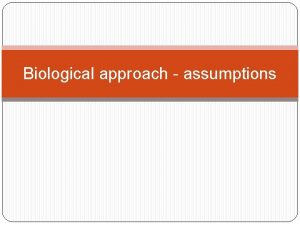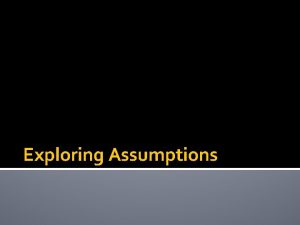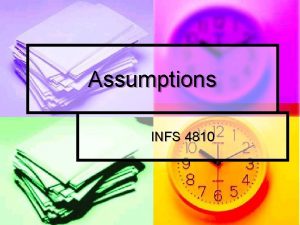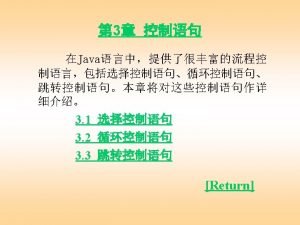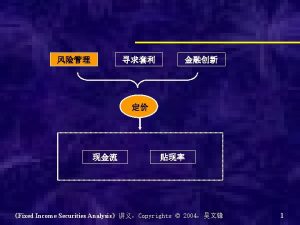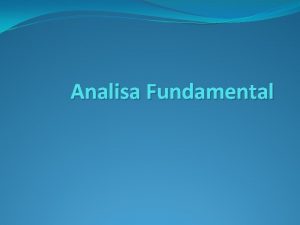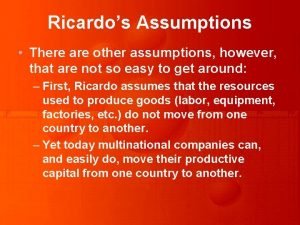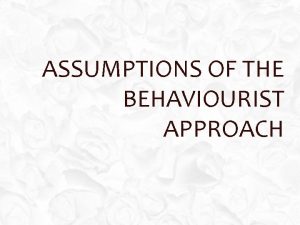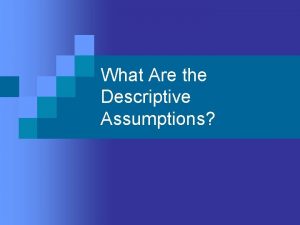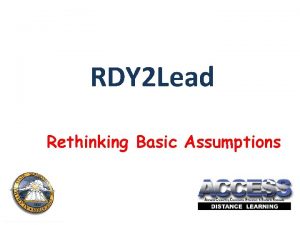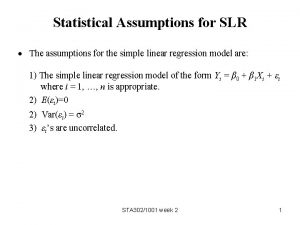Return to Assumptions Recall the two fundamental assumptions



















- Slides: 19

Return to Assumptions • Recall the two fundamental assumptions of the standard radiosity approach: – Constant radiosity over each element (today) – Perfectly diffuse surfaces (next week) • We wish to more accurately represent the radiosity at every point: – Regardless of the quality of the solution (form factors, subdivision, etc. ), if the correct radiosity cannot be represented, it won’t be computed

Better Radiosity Representations • Two approaches: – Work around the constant radiosity assumption by constructing meshes where elements really should have constant (or bilinear) radiosity – Use more expressive representations for radiosity (work under different assumptions)

Meshing Artifacts • Where does poor meshing really show? • Find the (many) artifacts in the following image

Typical Meshing • Lays down an orthogonal grid in some orientation • May subdivide, but the principle directions remain unchanged • Require subdivision down to pixel resolution to remove artifacts

Staircase Effect • Most evident at shadow boundaries: – Elements are dark if they have more than half shadow, light otherwise • Solution: – Subdivide the mesh to sub-pixel resolution (costly) – Blur the boundaries (introduces other problems) – Align element boundaries with the shadow boundaries (discontinuity meshing, later)

Light and Shadow Leaks • Occur when the mesh does not respect geometric boundaries – Interior walls meeting the floor • The wall appears to float – Shadows leaking out from under objects • No reasonable perceptual interpretation • Solutions: – Ensure that there are element boundaries at geometric intersections (hard to do without user help) – Discontinuity meshing

Interpolation Artifacts • Have to “fill in” radiosity between vertices, or blur element boundaries • Interpolation schemes are frequently poorly implemented, particularly those in hardware • Solutions: – Meshes that make interpolation easier – More expensive interpolation

Preprocessing the Mesh • Seek to remove inconsistencies before starting the solution • Ensure invariants are met: – Objects are solid – Objects don’t intersect • This is very hard to do automatically, it should be part of the modeling process • But, commercial modelers are generally poor in this regard

Fixing Interpolation • Pre-process to remove concave polygons – Replace them with triangles - not too hard • Enforce subdivision constraints – Neighboring patches cannot differ by more than one subdivision level • Post-process the remove T-vertices – Subdivide mismatched neighbors and interpolate new vertices correctly

Smoother Interpolants • Bi-linear (hardware accelerated) interpolation uses only vertices of given polygon • Build higher order interpolants – Must make sure not to use a high-order interpolant across a low order discontinuity • Gather to a texture or cloud of points • Gather to pixels in the image (slow)

Discontinuity Meshing • Identify expected discontinuities and mesh around them – Sharp boundaries due to point light sources or object contact – Derivative discontinuities due to area sources and multi-object shadows • Related to aspect graphs in computer vision – Places where the set of visible things changes

Two Types of Discontinuities • Assume polygonal environment • Vertex-Edge events – Discontinuities where the plane defined by a vertex and an edge intersects other objects • Edge-Edge – Higher order discontinuities at places where three edges appear to meet at a point – Generally ignored

Meshing With Discontinuities • Construct VE planes • Intersect them with surfaces • Mesh the resulting edges – Constrained triangulation is a difficult problem • Mesh must be able to store different radiosity values at one point

Using Discontinuity Meshes • Very high number of possible discontinuities: O(n 6) for n vertices • Only find discontinuities due to bright light sources • Try to only find visible discontinuities • Research topic: Integrate into hierarchical scheme

Better Radiosity Representations • Standard approach: Each point takes on the value of the patch on which it lies: • Finite Element Approach: The radiosity at each point is given by a linear combination of basis functions evaluated at that point:

Finite Element Formulation • Note the similarity to splines: a set of weights multiply a set of basis functions to give a value • Choose a set of basis functions that can capture the desired behavior • Find the coefficients, Bj, that give the best solution

Galerkin Method • Find the set of weights that minimize the variation of the found solution from the true solution • In other words: Find the closest expressible solution to the true one • The standard radiosity equation, with accurate form factors, is a Galerkin method with constant basis functions of finite support (supported by each patch)

Point-Collocation Method • Find the set of weights that zero the error at a fixed set of points • The hemicube algorithm implements a point -collocation method for the radiosity equation • Not as accurate as the Galerkin method: – Only locally accurate, as opposed to globally optimal

Alternate Bases • Linear basis functions • Wavelets: – Multi-resolution representation – Behaves like hierarchical radiosity, but without redundant information
 What is the biological approach
What is the biological approach Two fundamental business strategies are
Two fundamental business strategies are Two fundamental business strategies are
Two fundamental business strategies are Hát kết hợp bộ gõ cơ thể
Hát kết hợp bộ gõ cơ thể Slidetodoc
Slidetodoc Bổ thể
Bổ thể Tỉ lệ cơ thể trẻ em
Tỉ lệ cơ thể trẻ em Gấu đi như thế nào
Gấu đi như thế nào Chụp phim tư thế worms-breton
Chụp phim tư thế worms-breton Bài hát chúa yêu trần thế alleluia
Bài hát chúa yêu trần thế alleluia Môn thể thao bắt đầu bằng từ chạy
Môn thể thao bắt đầu bằng từ chạy Thế nào là hệ số cao nhất
Thế nào là hệ số cao nhất Các châu lục và đại dương trên thế giới
Các châu lục và đại dương trên thế giới Công thức tính thế năng
Công thức tính thế năng Trời xanh đây là của chúng ta thể thơ
Trời xanh đây là của chúng ta thể thơ Mật thư tọa độ 5x5
Mật thư tọa độ 5x5 101012 bằng
101012 bằng độ dài liên kết
độ dài liên kết Các châu lục và đại dương trên thế giới
Các châu lục và đại dương trên thế giới Thơ thất ngôn tứ tuyệt đường luật
Thơ thất ngôn tứ tuyệt đường luật
